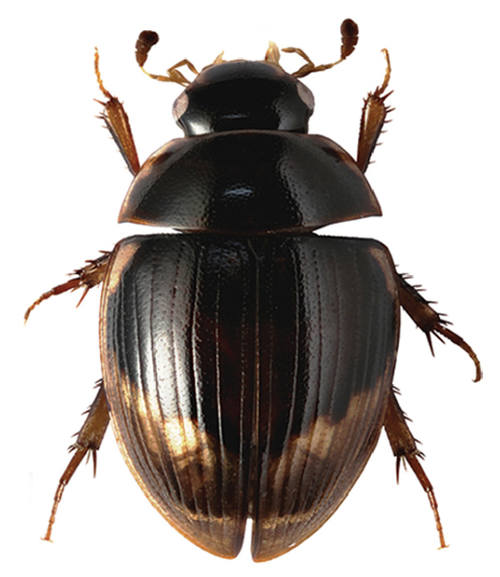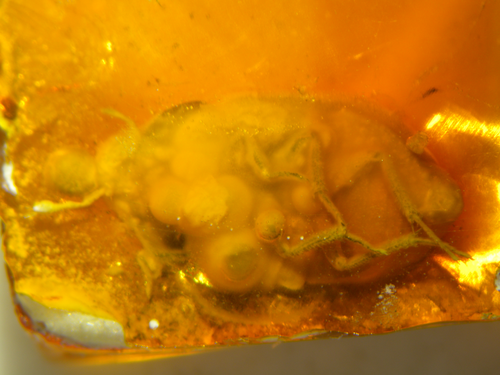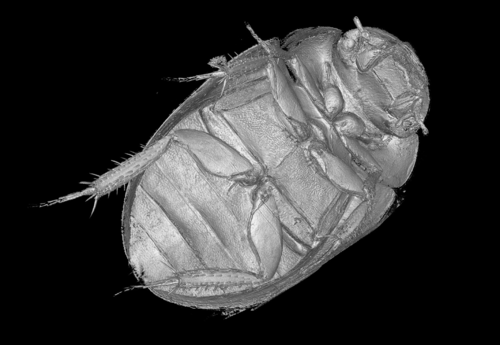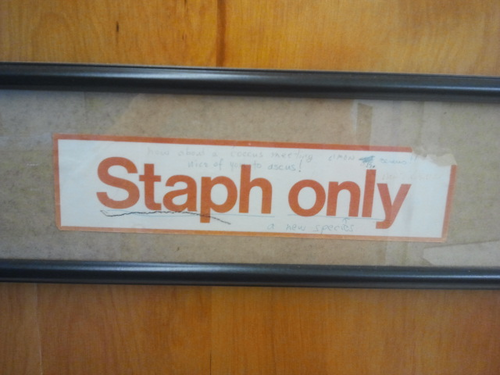This post was written by Emmanuel Arriaga Varela.
 In order to understand the Hows, the Whens and the Whys of the evolution of insects and other animal groups, it is necessary to take a look at the past. Fossils embedded in amber give us the unique opportunity to take a deep and intimate look at a moment frozen in time. Through careful examination of the morphology of these organisms and a comparison with extant groups it is possible to place them within the framework of an evolutionary tree. Moreover, the morphological, geological and biogeographical aspects of the fossil record are invaluable in the reconstruction of a comprehensive evolutionary history.
In order to understand the Hows, the Whens and the Whys of the evolution of insects and other animal groups, it is necessary to take a look at the past. Fossils embedded in amber give us the unique opportunity to take a deep and intimate look at a moment frozen in time. Through careful examination of the morphology of these organisms and a comparison with extant groups it is possible to place them within the framework of an evolutionary tree. Moreover, the morphological, geological and biogeographical aspects of the fossil record are invaluable in the reconstruction of a comprehensive evolutionary history.The global aim of my PhD project at Charles University in Prague is to understand the biodiversity explosion of the terrestrial water scavenger beetles (Family Hydrophilidae, tribe Megasternini). I am reconstructing the phylogenetic relationships within this group based on the genetic information and complemented by the main morphological traits of the organisms. Any knowledge about the extinct members of this group and their close relatives is crucial on the way towards understanding of evolutionary patterns.

Sometimes the quality of amber embedded fossils is not optimal for its study with conventional tools.

3D reconstruction of micro-CT scans allow us to study the morphology of fossils specimens in amazing detail.
 All the available hydrophilid fossils from Baltic amber from the Eocene epoch were scanned using micro computerized tomography in the laboratory of Brian Metscher at the Department of Theoretical Biology, University of Vienna. As part of my BIG4 secondment, I visited the laboratory of Adam Brunke in the Canadian National Collection of Insects, Arachnids, and Nematodes at the Agriculture and Agri-Food Canada, Ottawa. Adam, a successful graduate of the BIG4 project himself, made an exemption to his "Staph only" policy and diverged from his beloved staphylinids instructing me in the use of specialized software for the construction of 3D models from the X-ray micro-CT scans. These reconstructions allowed us to examine the morphological structures in a way that otherwise would be impossible. Now, we will be able to use this information for the calibration of the branching events in the evolutionary tree of Hydrophilidae.
All the available hydrophilid fossils from Baltic amber from the Eocene epoch were scanned using micro computerized tomography in the laboratory of Brian Metscher at the Department of Theoretical Biology, University of Vienna. As part of my BIG4 secondment, I visited the laboratory of Adam Brunke in the Canadian National Collection of Insects, Arachnids, and Nematodes at the Agriculture and Agri-Food Canada, Ottawa. Adam, a successful graduate of the BIG4 project himself, made an exemption to his "Staph only" policy and diverged from his beloved staphylinids instructing me in the use of specialized software for the construction of 3D models from the X-ray micro-CT scans. These reconstructions allowed us to examine the morphological structures in a way that otherwise would be impossible. Now, we will be able to use this information for the calibration of the branching events in the evolutionary tree of Hydrophilidae.
As part of the BIG4 project I had the chance to learn modern methods for the study of insect diversity and I was lucky to meet and even to collaborate with many of the top scientists in this area of knowledge. I will definitely utilize this acquired knowledge and connections in the future.
After the examination of the only known potential member of my subject of study group, we discovered that it is actually not even a hydrophilid, but a member of a distant beetle family. However, in the study of extinct and extant biodiversity any discovery that bring us closer to the truth is a step forward, and that is something that should makes us all happy.
Publications within the project:
- Arriaga-Varela E, Wong SY, Kirejtshuk A, Fikácek M (2018) Review of the flower-inhabiting water scavenger beetle genus Cycreon (Coleoptera, Hydrophilidae), with descriptions of new species and comments on its biology. Deutsche Entomologische Zeitschrift 65(1): 99-115. https://doi.org/10.3897/dez.65.26261
- Arriaga-Varela, E., Seidel, M., Fikáček, M. 2018. A new genus of coprophagous water scavenger beetle from Africa (Coleoptera, Hydrophilidae, Sphaeridiinae, Megasternini) with a discussion on the Cercyon subgenus Acycreon. African Invertebrates 59(1): 1-23. https://doi.org/10.3897/AfrInvertebr.59.14621
- Arriaga-Varela, E., Seidel M., Deler-Hernández A., Senderov V. & Fikacek M. 2017. A review of Cercyon Leach (Coleoptera, Hydrophilidae, Sphaeridiinae) of the Greater Antilles. ZooKeys 681: 39-93
- Toussaint E. A. F., Seidel M., Arriaga-Varela E., Hájek J., Král D., Sekerka L., Short A. E. Z. & Fikáček M. 2017: The peril of dating beetles. Systematic Entomology 42(1): 1-10. DOI: 10.1111/syen.12198

